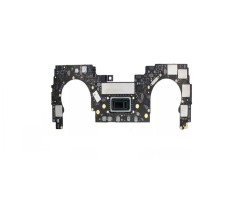A Closer Look at the Parts of a Ship and Their Functions
Discover the key parts of a ship, from the hull and deck to the engine room, and learn how each component works to keep vessels afloat

Ships are one of the oldest and most vital forms of transportation, and their design is both complex and highly functional. From ancient seafaring vessels to the modern cruise ships and container carriers of today, every part of a ship serves a specific purpose to ensure safe, efficient, and effective travel across the seas. Whether you're interested in maritime engineering or simply want to know more about how ships work, understanding the main parts of a ship is essential. Let's dive into the anatomy of a vessel and explore the key components that make up a ship.
Hull
The hull is the main body of the ship and forms its structure. It's designed to provide buoyancy, stability, and strength, ensuring the ship stays afloat. The hull is typically made from steel, aluminum, or wood, depending on the type of ship. It's designed to withstand the harsh conditions of the sea, including rough waters, high winds, and saltwater corrosion.
There are different types of hulls:
- Displacement Hull: Designed to push water aside, typically used in cargo ships and ocean liners.
- Planing Hull: These hulls are more commonly seen on speedboats, allowing the ship to glide over the water at high speeds.
- Catamaran Hull: Featuring two parallel hulls, this design offers stability and is used in both passenger ferries and military vessels.
Deck
The deck is the horizontal surface that covers the hull and is divided into multiple levels, or floors. Each deck is designated for specific activities or functions. For example, the main deck is the topmost layer, providing space for crew members, passengers, cargo, or machinery. Below the main deck, there are often additional decks used for storage, engines, and living quarters.
Ships often have several types of decks, such as:
- Weather Deck: Exposed to the elements, it’s the uppermost part of the ship.
- Cargo Deck: For carrying freight, typically seen on cargo ships.
- Bridge Deck: Located near the control room or bridge.
Bow
The bow is the front part of the ship, often referred to as the “head” of the ship. This part is designed to slice through the water as the ship moves forward. The bow shape is vital for hydrodynamics and minimizing resistance. It often has a sharper angle to cut through the water more efficiently, helping with the ship’s speed and fuel efficiency.
A well-designed bow reduces the ship’s drag, which is crucial for the vessel’s speed and fuel consumption, especially for large cargo ships.
Stern
Opposite to the bow, the stern is the rear end of the ship. It plays a significant role in the stability and maneuverability of the vessel. On most ships, the rudder is attached near the stern to help steer the vessel. The stern also houses the ship's propellers, which are responsible for propelling the ship forward or backward.
On large ships, the stern often has a transom, which is the flat or slightly curved surface at the very back of the ship. This area is important for supporting the rudder and stabilizing the ship's motion.
Propeller
The propeller is one of the most crucial parts of a ship, as it is responsible for generating thrust and moving the vessel through the water. Propellers typically consist of rotating blades attached to a shaft that is powered by the ship’s engine. As the blades spin, they push water backward, propelling the ship forward in the opposite direction.
Most large ships use multi-blade propellers for efficiency. Some modern vessels also use azimuth thrusters or waterjets, which provide better maneuverability, especially for vessels that need to navigate narrow or congested areas like ports.
Rudder
The rudder is a flat, vertical blade located at the stern of the ship, used to steer and control the direction of the vessel. When the rudder is turned, it alters the flow of water around the ship, creating a force that turns the ship to port (left) or starboard (right). The rudder is typically controlled by the ship’s helm or steering system.
Larger ships, such as container ships and tankers, may have multiple rudders for enhanced control, particularly in rough waters or at slower speeds.
Bridge
The bridge is the command center of the ship, where the captain and crew control and navigate the vessel. Located high above the main deck, the bridge provides a clear view of the surrounding waters and is equipped with various instruments and technologies for navigation. These include:
- Radar: Used to detect other vessels and landmasses.
- GPS Systems: For precise positioning and course plotting.
- Communication Equipment: To maintain contact with other ships, ports, and maritime authorities.
- Steering Controls: To direct the rudder and control the ship’s direction.
The bridge also houses important safety equipment, including emergency controls and communication devices.
Cargo Hold
On cargo ships, the cargo hold is a large, enclosed space below deck used for storing goods and materials during transit. Cargo holds are designed to accommodate different types of cargo, from bulk goods like grain to large containers or even liquid cargo in tanks. Cargo holds are usually equipped with winches and cranes to load and unload cargo efficiently.
Some specialized ships, such as tankers or container ships, have specific cargo holds designed to safely transport liquid or containerized goods.
Anchor and Chain
The anchor is a heavy metal object designed to keep the ship stationary when it is moored or at rest. It is lowered to the seabed using a chain, which can be very long, depending on the water depth. The anchor is crucial for preventing a ship from drifting when it is in harbor or during rough weather.
Modern ships may have more than one anchor, typically located at the bow and stern, and they may use automatic or hydraulic systems to drop or retrieve the anchor.
Engine Room
The engine room is the powerhouse of the ship, where the engines, turbines, and generators are located. These systems provide the power necessary for propulsion, electrical systems, and other operations. Depending on the type of ship, the engine room may contain:
- Main Engine: Powers the ship’s propeller and provides propulsion.
- Auxiliary Engines: Provide power for the ship's electrical systems, heating, and other operations.
- Generators: Supply electricity for the ship’s lighting, navigation, and communication systems.
The engine room also contains vital systems such as fuel tanks, cooling systems, and emergency backups to ensure smooth operation during long voyages.
Superstructure
The superstructure is the part of the ship that extends above the main deck and houses various crew quarters, control rooms, and other facilities. On passenger ships, the superstructure includes lounges, dining areas, cabins, and entertainment spaces. On cargo ships, it typically contains the bridge, cargo control rooms, and engineering areas.
The superstructure is essential for providing shelter, safety, and comfort for the crew and passengers.
Conclusion
Understanding the parts of a ship is key to appreciating how these complex vessels operate. Each part, from the hull and deck to the rudder and engine room, is designed to work together to ensure that the ship can safely and efficiently carry passengers or cargo across the seas. Whether you're looking at a modern luxury cruise ship or a large container vessel, each component plays an essential role in the ship's overall function and performance.
By familiarizing yourself with the various parts of a ship, you gain a better understanding of the intricacies of maritime travel and logistics that keep the global economy moving. Ships truly are marvels of engineering and innovation, and their design continues to evolve as new technologies shape the future of the maritime industry.
What's Your Reaction?



















